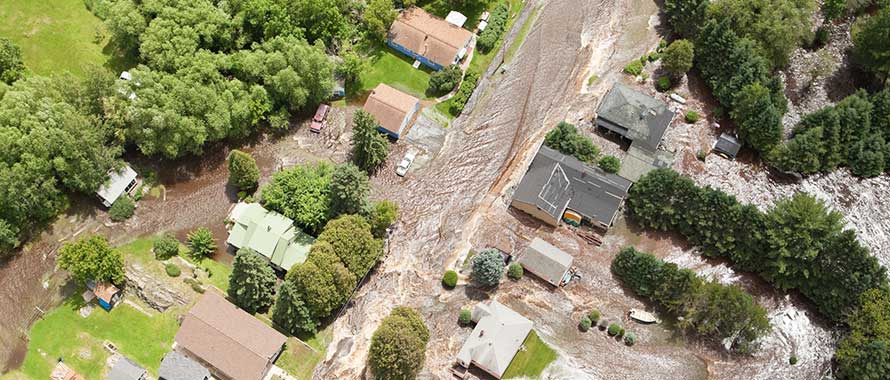NFIP falls short in large loss situations
Floods may be the number one natural disaster in the United States; however, despite causing over $6 billion in damages each year, many homes and businesses remain underinsured.
It may be that those who live outside of high-risk flood zones feel it is unnecessary, while others, who carry a minimum of coverage, underestimate the risk. Whatever the reason, it is a dangerous bet and an opportunity for retail brokers and agents to explain the odds for clients.
LOW- AND HIGH-RISK FLOOD ZONES EQUAL RISK
Consider that Florida was the top state for flood claims in 2014, naturally, but Iowa was also listed a top-ten state for total claim payments. “Nearly every property is subject to flood risk,” said Kasey Vaughn, Corporate Vice President and Managing Director, Burns & Wilcox in North Carolina.
“Flood insurance is required if you have a mortgage, and can carry a penalty if the homeowner or business owner is underinsured in high-risk areas,” noted Vaughn. “It is required that 90 percent of private home value is insured and 80 percent of the value on commercial property.”
Even though Flood insurance is not federally required for those outside high-risk areas, it is important to note the risk and financial vulnerability. One in four flood claims is for a home that is not in a high-hazard zone, but within the lower flood hazard zone or 500-year zone (B, C or X), which are defined as areas with 0.2 to 1 percent annual chance flooding.
In fact, people outside of mapped high-risk flood areas file over 20 percent of all National Flood Insurance Program (NFIP) claims and receive one-third of Federal Disaster Assistance for flooding.
Standard insurance policies do not cover floodwater damage, and NFIP policies top out at $350,000 for a home and contents.
People outside of mapped high-risk flood areas file over 20 percent of all National Flood Insurance Program (NFIP) claims.
“A flood doesn’t have to be catastrophic to reach those limits for homeowners with high-value-contents,” added Vaughn. Brokers and agents can work with a specialty wholesaler to identify these potential gaps in coverage.
Even high-risk areas mapped and designated by the Coastal Barrier Resources Systems (CBRA), where NFIP coverage is unavailable for structures built after certain dates, with extended coverage, clients can be covered up to $1 million with a specialty wholesaler.
FLOOD ZONES ARE TRICKY TO MAP
A lot of factors go in to quoting a Flood policy. This includes the location, flood zone, elevation, foundation, type of construction, number of floors, along with the loss history and the community’s loss history.
“It’s important to note that NFIP flood zone maps can be inaccurate and out-of-date,” said Vaughn. “Being inland in a lower risk flood zone means, in a heavy rainstorm, the water doesn’t have anywhere to drain, so it is more susceptible to flash flooding and sewer backup. In addition, it also takes longer for the water to drain, resulting in increased damage.”
The storm surge risk is not accounted for on an NFIP map that only identifies elevations, adding a level of complexity when assessing the exposure to a home. Brokers and agents can work closely with a wholesaler to ensure proper coverage for these unique risks.
It is also important to point out to homeowners that flood plain maps evolve, and even if they were not in a flood plain when they bought their home, they now may be in a higher hazard flood zone.
COMMERCIAL PROPERTY
“Retail brokers and agents have an opportunity to have a discussion with both homeowners–especially those with high-value homes–and business owners, on where there may be gaps in their coverage,” says Vaughn.
Primary coverage may be available at rates more favorable than the NFIP for commercial property owners. For those in high-risk areas, there are excess flood programs if the client doesn’t qualify for a commercial primary flood program. While NFIP coverage limits the building and contents to $500,000 each, that is often not nearly enough to cover catastrophic loss. Wholesalers however can offer as much as $5 million on a building and $1 million on contents as well as business income (max combined $5.1 million). With an excess flood program, a building and its contents can be covered at $20 million and $2 million dollars (max combined $20 million), respectively.
“When it comes to business owners, it is really about providing a comprehensive policy that allows them to sleep at night,” Vaughn said. “An NFIP policy can’t cover multiple locations, they require photos to bind coverage and there’s a waiting period, among other items. In a crisis, clients don’t want to worry about what is in the fine print.”
Whether you are on the coast or in the heartland, almost everyone can relate to the destructive force of flooding. With thorough evaluation and assessment, brokers and agents can provide peace of mind for homeowners and business owners who want to protect their most valuable assets.




